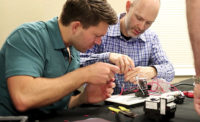
Ron Spataro, Director of Marketing, and Steve Foutch, Vice President Sales and Operations, both of AVO Training Institute, Dallas, TX (www.avotraining.com; 877-594-3156; 214-330-3522) answer questions from ISHN magazine about electrical safety training.
What skills make for a good instructor?
Ron: Experience in markets such as industrial, utilities, and mining. We hire instructors from the areas that we market to, so the instructors know intimately the needs of those markets.
Steve: Experience is basically you’ve walked the walk, do you have the ability to talk about it? You need good communication skills – electronic, personal, oral, written. You’ve got to stand in front of 12-20 strangers with varying levels of experience; students could be experts, could be novices. They all aren’t at the same competency level at beginning.
What is the optimal student to instructor ratio?
Steve: Depends on the subject of the training. Of course, the intensity and hands-on lab exercises each student has to perform means that some courses have perhaps six students. Then again, your basic instructor-led, more general safety courses in an auditorium could have one instructor for 75 or 375 people.
Ron: What’s important about the ratio is to make sure each student “gets it.”
How does an instructor handle the diversity of students’ experience and competency levels?
Steve: You pretest first in a particular course so you know what competency level you are dealing with. More importantly, as a teacher you want to know where competency levels are so you can bring competencies up faster to a level where everyone else is.
How do you determine the competency level of students upon completion of training?
Steve: The test. Each course has a test. That test is graded. The student needs to receive no less than 80% in the final test, and in labs must show proficiency in lab hands-on work. Probably 97% pass the written test.
Ron: The bottom line is you don’t leave training without learning.
Steve: You know, some people stretch their capabilities. Some will say, “Sure I can drive a school bus, it’s just like driving a car.” Or “Yeah, I just put shingles on my house, it’s just like working for a construction company. No difference, know what I mean?”
How does an employer decide who is qualified to perform electrical work and who is not?
Ron: The key word there is qualified. A qualified person has been trained and shows proficiency in completing their task. A qualified worker is defined in OSHA regulations; NFPA 70E highlights what that definition is, if you don’t perform that task at least once every six months, you lose that qualified status. That’s why AVO emphasizes hands-on, because they must demonstrate their abilities.
Steve: Take the circuit breaker course – can you take a circuit breaker apart and put it back together without getting injured or killed?
Ron: NFPA 70E states in plain language – to be a qualified worker you have to demonstrate proficiency, you must attend a lab and show someone you are a qualified person. NFPA covers LOTO (lockout-tagout); if you’re not safety trained, you may not know you have to do those things.
Steve: It’s the same with your car’s engine repairs and brakes – you take your car to Mr. Goodwrench because you’re confident that he’s been trained.
Do you think the majority of industrial workplaces realize electrical hazards cause more than 300 deaths and 4,000 injuries in the workplace every year?
Ron: No. A culture change is necessary from management to make sure that they are providing the best possible safety and maintenance training available. Change starts at the top.
Steve: It starts at the top to ensure it is a management concern. And then you move next to provide a company with an electrical safety program for mid-management to follow so that managers can appropriately train the employees, both qualified and non-qualified workers. One death, one accident is too many when it could have been prevented with the safest and hands-on training. In too many cases, management may be asking a guy with a tool belt to do things that aren’t safe. If managers are trained, they won’t ask a technician to fix something they are not trained to fix safely. We’re coming out of the syndrome of the good old boy days – “go fix that.” Just do it. Listen, just because you enjoy tinkering doesn’t make you a certified Mr. Goodwrench. But a lot of these techs don’t like to explain to the boss why they can’t do something. You know, good old boys just do stuff, fix stuff.
Ron: You have to change that culture where the boss says go fix it, and the techs go fix it, no questions asked. We’re going through a transition like when auto seat belts first came out. Not everyone used them. But they were safer and better. So in some workplaces we’re going from no electrical safety program to the rules and standards of OSHA, NEC, NFPA. This is now what you have to know and do.
Why is it that, too often, the safety training development project is assigned to a “safety expert,” with little electrical knowledge, or to an electrical expert, with little safety knowledge?
Steve: Because culture or human nature usually assigns tasks to individuals who can complete them, it does not mean they have that experience – there’s that logic jump right there. You may have a guy who knows something about electricity and they assume he is a subject matter expert (SME). A company might put in an electrical safety program, but doesn’t have an electrician on staff. So it assigns the task to a manager to implement that program. An electrical safety SME is not a management task or staffing position in smaller companies, so you assign the task. Usually a 500-employee company has an engineer on staff. He may want to do arc flash analyses, never having done one in his life, but he’s an engineer, plus the company will save money – it’s economics. Is the maintenance guy a good old boy who knows tools or is he an electrician? “Go ahead Uncle Bob, fix it.” He opens up the panel – boom. “Hey, it didn’t say stay 18 feet away with this PPE.”
Estimate how many worksites in general industry operate effective Arc Flash Hazard Safety Programs.
Steve: It’s not 100%, probably never will be 100%, but you don’t want it to be you. I don’t think the marketplace really understands in general their liability – there just hasn’t been a death, they haven’t had the education, they pay for potential burn or injury, but if the building burns down, uh oh.
It’s matter of education and money. You safeguard like you do at home. You look at the tires of your kids’ cars; you don’t want that catastrophe of changing a tire on the side of road, you don’t want the car destroyed, you sure don’t want your child or their friends dead. So you make a judgment to safeguard, or you face the consequences when they happen.
A lot of these things are preventable. There is no maintenance work done. The attitude is, “If it ain’t broke, don’t fix it.” Well, then several pieces of equipment in a manufacturing process are in need of change, pieces not that important break down. You ask some guy to fix it without LOTO, you don’t want to stop your production. If you maintained it, it wouldn’t break. A lot of circuit breakers have not been maintained in years
How many employers know that: “Arc Flash is the sudden release of electrical energy through the air when an arcing fault occurs between phase-to-phase, phase-to-neutral, or phase-to-ground conductors. An Arc Flash gives off thermal radiation (heat) and bright, intense light. Temperatures have been recorded as high as 35,000˚F. This extreme temperature melts and vaporizes metals and can ignite clothing and cause fatal burns as far as 10 feet away.”
Ron: Not near enough. A lot of people don’t even know what an arc flash is.


